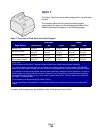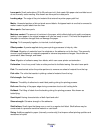
Glossary
117
Corner buckler. The metal tab at the corner of a paper tray that helps the printer separate one sheet
of paper from the stack during the pick process.
Curl. Waviness or curvature at the edge of the material that is generally moisture related.
Cut sheet. Single piece (page) of paper or label stock.
Debossing. Process of pressing an image down into the surface of the label or card stock. See also
Embossing.
Delamination. The peeling of labels off the backing during the printing process.
Die-cut. Labels: Cut of material (face stock) to form individual labels on sheet. Cuts do not penetrate
the liner. Card Stock: Cuts made with dies to create the shapes wanted in the stock. Cuts may or may
not go completely through the stock. See also Ties.
Driver edge. For printers that use a fixed reference for feeding paper through the paper path (as
opposed to printers that center paper in the path), the edge of the print material that is positioned
next to the hardware reference and that is driven by the rollers in the printer. For most Lexmark
printers, the driver edge is the left edge of a portrait page.
Embossing. Process of raising the surface of the base material by stamping an image or design with
an embossing machine. The machine has a roll with a raised image on the surface. As the print
material passes through the machine, the image is pressed into the material. See also Debossing.
Feed. How well the stock moves out of the paper tray and through the printer.
Fiber content. The material used to manufacture the paper. Most high-quality xerographic paper is
made from 100% chemically pulped wood. This content provides the paper with a high degree of
stability resulting in fewer paper feeding problems and better print quality. Paper containing fibers
such as cotton have characteristics that can result in degraded paper feeding.
Fuse grade. Qualitative measurement of the adhesion of toner to the printed sheet.
Fusing. Printer process of melting toner and adhering it to the print material.
Glue contamination. See Adhesive contamination.
Grain. The orientation of the fibers in the print material. Grain short indicates the fibers run the width
of the paper. Grain long indicates the fibers run the length of the paper.
Ink contamination. Transfer of ink from a form to the printer’s pick mechanism or fuser assembly,
which can cause printer contamination.
Ironing. A mechanical process used during conversion to flatten stock.
Laser ink. Inks that can withstand fuser temperatures of 225°C (437°F) and pressures to 25 psi
without contaminating the printer or releasing hazardous fumes.


















